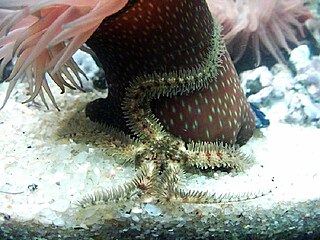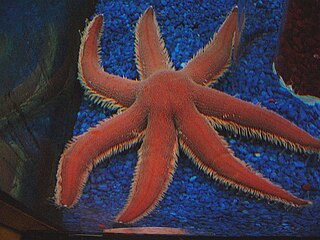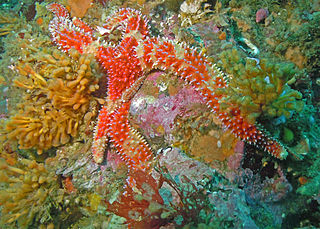Related Research Articles

An echinoderm is any member of the phylum Echinodermata of marine animals. The adults are recognizable by their radial symmetry, and include starfish, sea urchins, sand dollars, and sea cucumbers, as well as the sea lilies or "stone lilies". Adult echinoderms are found on the sea bed at every ocean depth, from the intertidal zone to the abyssal zone. The phylum contains about 7000 living species, making it the second-largest grouping of deuterostomes, after the chordates. Echinoderms are the largest phylum that has no freshwater or terrestrial members.

Sea urchins, are typically spiny, globular animals, echinoderms in the class Echinoidea. About 950 species live on the seabed, inhabiting all oceans and depth zones from the intertidal to 5,000 metres. Their hard shells (tests) are round and spiny, usually from 3 to 10 cm across. Sea urchins move slowly, crawling with their tube feet, and sometimes pushing themselves with their spines. They feed primarily on algae but also eat slow-moving or sessile animals. Their predators include sea otters, starfish, wolf eels, triggerfish, and humans.

Starfish or sea stars are star-shaped echinoderms belonging to the class Asteroidea. Common usage frequently finds these names being also applied to ophiuroids, which are correctly referred to as brittle stars or basket stars. Starfish are also known as Asteroids due to being in the class Asteroidea. About 1,500 species of starfish occur on the seabed in all the world's oceans, from the tropics to frigid polar waters. They are found from the intertidal zone down to abyssal depths, 6,000 m (20,000 ft) below the surface.

Protoreaster nodosus, commonly known as the horned sea star or chocolate chip sea star, is a species of sea star found in the warm, shallow waters of the Indo-Pacific region. They are sometimes seen in the marine aquarium trade.

Pycnopodia helianthoides, commonly known as the sunflower sea star, is a large sea star found in the northeast Pacific. The only species of its genus, it is among the largest sea stars in the world, with a maximum arm span of 1 m (3.3 ft). Sunflower sea stars usually have 16 to 24 limbs; their color can vary widely. They are predatory, feeding mostly on sea urchins, clams, snails, and other small invertebrates. Although the species had been widely distributed throughout the northeast Pacific, its population has rapidly declined since 2013.

Pisaster brevispinus, commonly called the pink sea star, giant pink sea star, or short-spined sea star, is a species of sea star in the northeast Pacific Ocean. It was first described to science by William Stimson in 1857. The type specimen was collected on a sandy bottom, 10 fathoms (18 m) deep, near the mouth of San Francisco Bay.

Pisaster ochraceus, generally known as the purple sea star, ochre sea star, or ochre starfish, is a common starfish found among the waters of the Pacific Ocean. Identified as a keystone species, P. ochraceus is considered an important indicator for the health of the intertidal zone.

Eccentric sand dollar, also known as the sea-cake, biscuit-urchin, western sand dollar, or Pacific sand dollar, is a member of the order Clypeasteroida, better known as sand dollars, a species of flattened, burrowing sea urchins found in the northeast Pacific Ocean from Alaska to Baja California.

Ophiothrix fragilis is a species of brittle star in the order Ophiurida. It is found around the coasts of western Europe and is known in Britain as the common brittle star. It is also found along the coast of South Africa where it is known as the hairy brittle star.

The seven-armed sea star is a species of sea star (starfish) in the family Luidiidae. It is found in the eastern Atlantic Ocean and the Mediterranean Sea.

Ophiocomina nigra, commonly known as the black brittle star or black serpent star, is a species of marine invertebrate in the order Ophiurida. It occurs in the north-eastern Atlantic Ocean, the North Sea and the Mediterranean Sea.

Astropecten spinulosus is a sea star of the family Astropectinidae.

Gorgonocephalus eucnemis is a species of basket star in the class Ophiuroidea. It is found in circumpolar marine environments in the Northern Hemisphere. The scientific name for the genus comes from the Greek, gorgós meaning "dreadful" and cephalus meaning "head", and refers to the similarity between these basket stars and the Gorgon's head from Greek mythology with its writhing serpents for hair. The specific name "eucnemis" is from the Greek "good" and "boot".

Evasterias troschelii is a species of starfish in the family Asteriidae. Its common names include the mottled star, false ochre sea star and Troschel's true star. It is found in Kamchatka and the north western coast of North America.

Astropecten articulatus, the royal starfish, is a West Atlantic sea star of the family Astropectinidae.
Stylasterias is a genus of starfish in the family Asteriidae. Stylasterias forreri, the velcro star, is the only species in the genus. It is found on the Pacific coast of Canada and the United States.

Orthasterias is a genus of sea stars in the family Asteriidae. Orthasterias koehleri, the rainbow star or red-banded sea star, is the only species in the genus. It is found in the North Pacific Ocean.

Ceramaster arcticus, the Arctic cookie star, is a species of sea star. It is pink and often has dark red accents. It has broad arms, no spines, and no pincers, or pedicellariae. It is considered rare and only inhabits the Pacific Ocean off the coast of northwestern North America.

Gorgonocephalus arcticus is a species of basket star in the class Ophiuroidea. The genus name comes from the Greek, gorgós meaning "dreaded" and cephalus meaning "head", and refers to the similarity between these echinoids and the Gorgon's head from Greek myth with its coiled serpents for hair.

Echinaster is a well-studied and common genus of starfish containing ~30 species and is the second-largest genus found within the family Echinasteridae. The genera Henricia and Echinaster encompass 90% of all the species found within the family Echinasteridae. It contains 30 species, however the number of species in this genus is still debatable because of uncertainty within the genera. This genus is currently sub-divided into two sub-genera: Echinaster and Othilia, evolutionary relationships between the sub-genera is not understood. Echinaster are found in the Pacific, Atlantic and Indian oceans, with most species being studied in the Gulf of Mexico and Brazil. The sub-genera Othilia is thought to encompass species mainly found in the Gulf of Mexico and Brazil. Echinaster is often one of the most studied species within the family Echinasteridae and is often used to find evolutionary relationships.
References
- ↑ "CalPhotos: Astrometis sertulifera; Fragile Rainbow Star".
- ↑ EF Ricketts, J Calvin, DW Phillips, JW Hedgepth. 1992. Between Pacific Tides, 5th edition. Stanford University Press: Stanford, CA. p. 92
- ↑ HS Jennings. 1907. Behavior of the starfish, Asterias forreri de Loriol. University of California Publ. Zool. 4:53-185. NOTE the species was misidentified in this work.
- RH Morris, DP Abbott & EC Haderlie. 1980. Intertidal Invertebrates of California. Stanford University Press: Stanford, CA. p. 122-123.